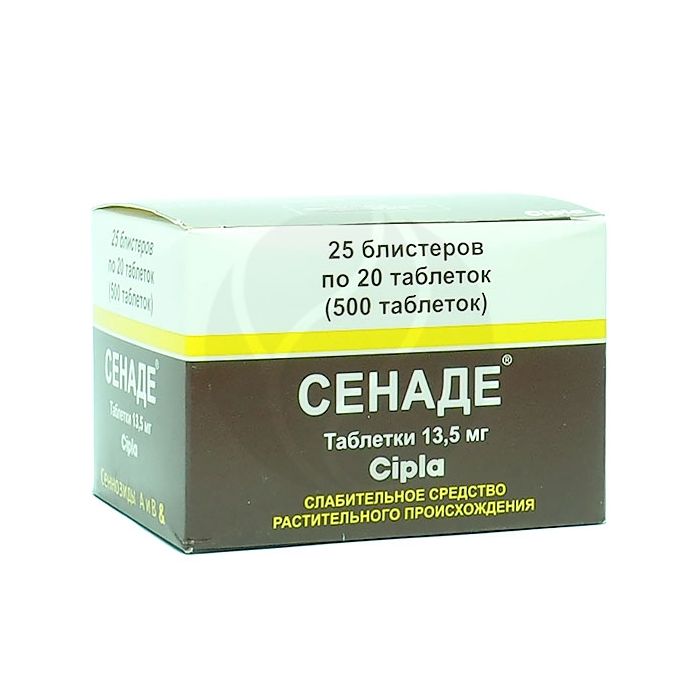Senade tablets, No. 500
Expiration Date: 05/2027
Russian Pharmacy name:
Сенаде таблетки, №500
constipation caused by hypotension and sluggish peristalsis of the large intestine;
stool regulation for hemorrhoids, proctitis, anal fissures.
The drug is administered orally, as a rule, 1 time / day in the evening before bedtime, washed down with water or any drink.
Adults and children over 12 years old - 1 tab. 1 time / day In the absence of effect, the dose can be increased to 2-3 tab.
Children aged 6-12 years are prescribed 1/2 tab. 1 time / day and, if necessary, increase the dose to 1-2 tab.
In the selection process, the same dose should be taken over several days and gradually increased by 1/2 tab. If, after reaching the maximum dose, there is no bowel movement within 3 days, you should consult a doctor.
The tablets are brown to dark brown interspersed, flat, round, with beveled edges, embossed with the word 'CIPLA' on one side and a fracture line on the other.
1 tab.
senna leaf extract 93.33 mg,
with the content of the sum of calcium salts of sennosides A and B in terms of sennoside B 13.5 mg
Excipients: lactose - 23.07 mg, starch - 43.56 mg, methyl parahydroxybenzoate - 0.04 mg, microcrystalline cellulose - 15 mg, talc - 11.13 mg, magnesium stearate - 0.93 mg, sodium lauryl sulfate - 0.93 mg, sodium carmellose - 2 mg.
spastic constipation;
intestinal obstruction;
abdominal pain of unknown origin;
strangulated hernia;
acute inflammatory diseases of the abdominal cavity;
peritonitis;
gastrointestinal and uterine bleeding;
cystitis;
violations of water and electrolyte metabolism;
hypersensitivity to the components of the drug.
It is prescribed with caution for liver and / or kidney diseases, during pregnancy, during breastfeeding, in conditions after abdominal operations.
pharmachologic effect
Herbal laxative. It has a laxative effect, which occurs after 8-10 hours. The laxative effect is due to the effect on the receptors of the large intestine, which enhances peristalsis.
Side effect
From the digestive system: colicky abdominal pains, flatulence are possible; with prolonged use, especially in high doses, melanin deposition in the intestinal mucosa, nausea, vomiting, diarrhea are possible.
From the side of metabolism: with prolonged use, especially in high doses, violations of water-electrolyte metabolism, deposition of melanin in the intestinal mucosa are possible.
From the urinary system: with prolonged use, especially in high doses, albuminuria, hematuria, discoloration of urine are possible.
From the side of the central nervous system: with prolonged use, especially in high doses, convulsions, fatigue, confusion are possible.
Dermatological reactions: with prolonged use, especially in high doses, skin rash is possible.
From the side of the cardiovascular system: with prolonged use, especially in high doses, vascular collapse is possible.
Application during pregnancy and lactation
SenadeЃ should be prescribed with caution during pregnancy and during breastfeeding.
Application for violations of liver function
It is prescribed with caution for liver diseases.
Application for impaired renal function
It is prescribed with caution for kidney disease.
Application in children
The drug is used in children aged 6 years and older.
special instructions
It is not recommended to use SenadeЃ for more than 2 weeks.
After taking the drug, urine may acquire a yellow-brown or red-lilac color.
Use in pediatrics
The drug is used in children aged 6 years and older.
Overdose
Symptoms: Diarrhea leading to dehydration.
Treatment: Increasing fluid intake is usually sufficient to compensate for fluid and electrolyte loss. In some cases, it is required to replace the loss of fluid and electrolytes with the help of intravenous infusion of plasma substitutes.
Drug interactions
With long-term use of SenadeЃ in high doses, it is possible to increase the action of cardiac glycosides and influence the action of antiarrhythmic drugs due to the possibility of hypokalemia.
With simultaneous use with thiazide diuretics, corticosteroids, licorice root preparations, the risk of hypokalemia increases.

